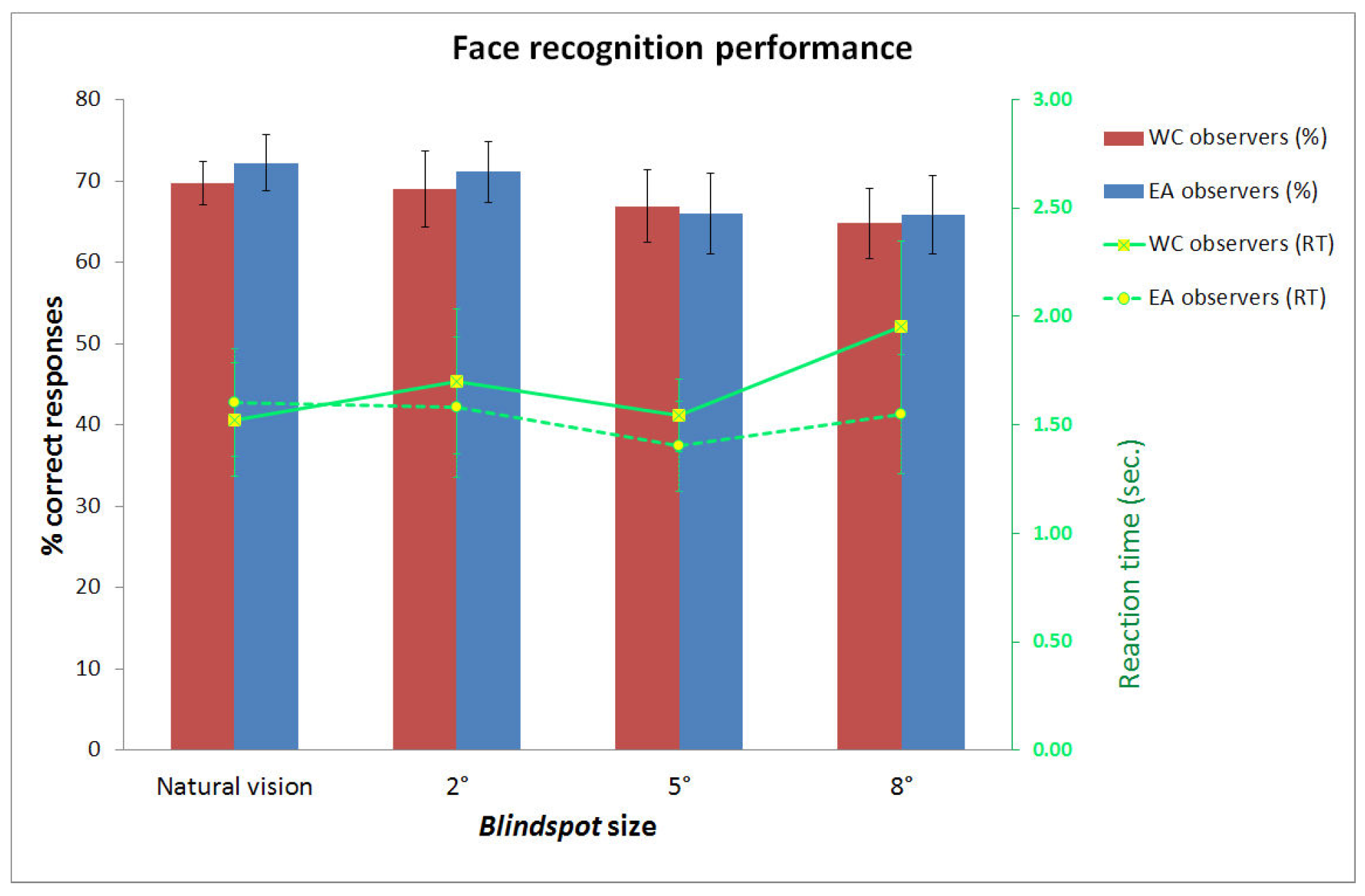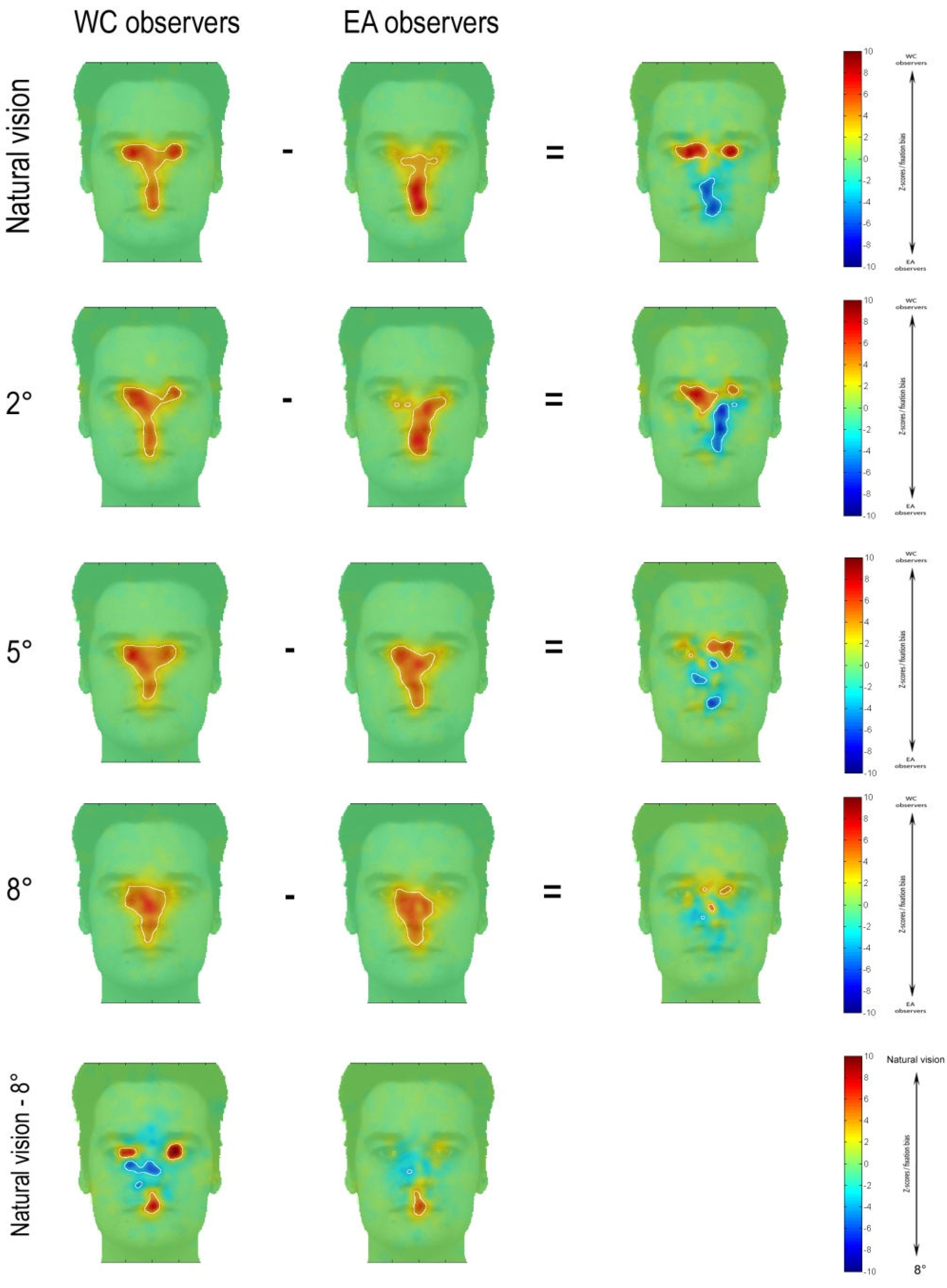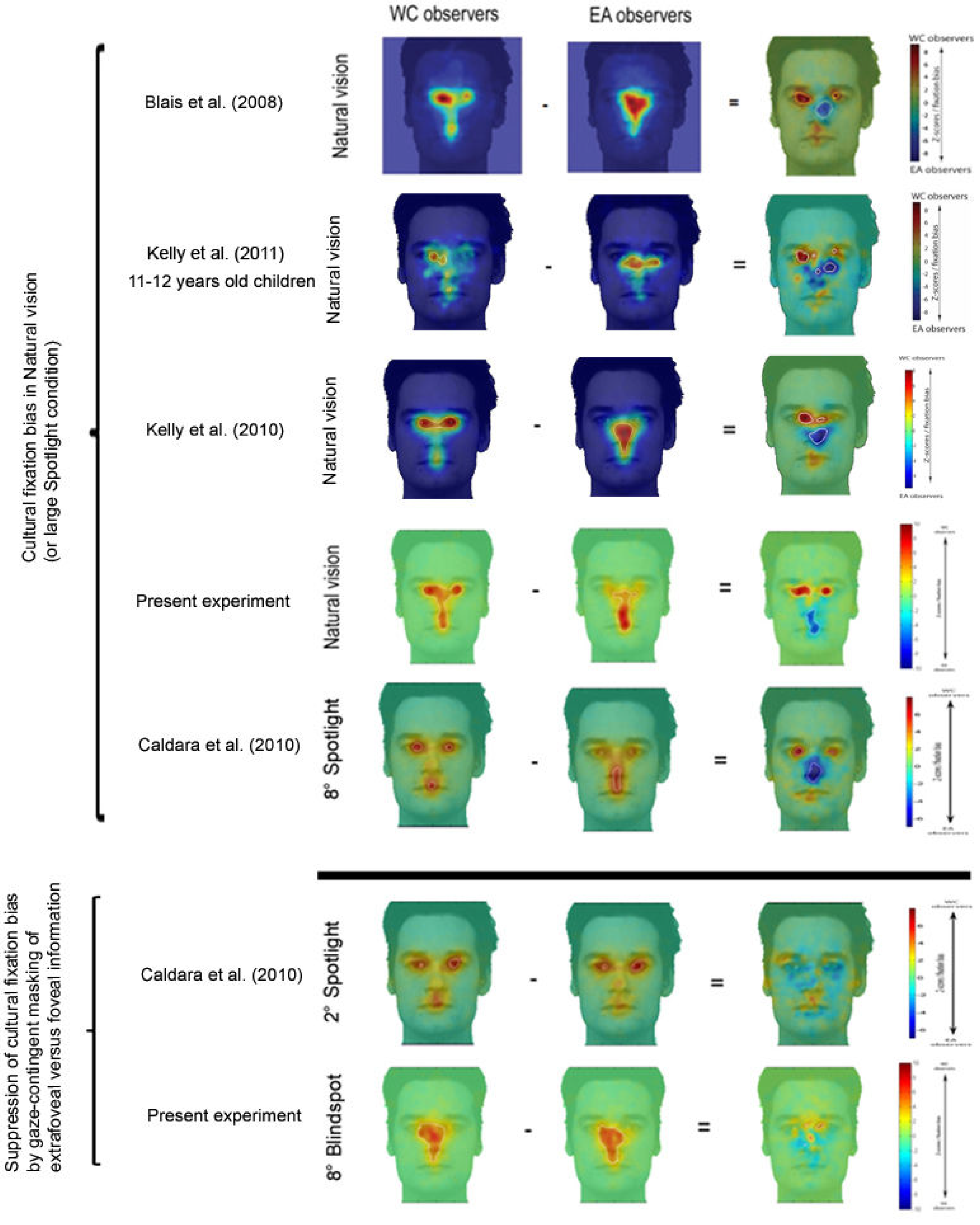When East Meets West: Gaze-Contingent Blindspots Abolish Cultural Diversity in Eye Movements for Faces
Abstract
:Introduction
Method
Participants
Stimuli
Eye-Tracking
Procedure
Data Analyses
Results
Behavioral Performance
Eye-Tracking Measures
Discussion
Acknowledgments
References
- Althoff, R. R., and N. J. Cohen. 1999. Eye-movementbased memory effect: a reprocessing effect in face perception. Journal of Experimental Psychology: Learning, Memory & Cognition 25: 997–1010. [Google Scholar]
- Bang, S., D. Kim, and S. Choi. 2001. Asian Face Image Database. Edited by Lab IM. Postech, Korea. [Google Scholar]
- Bertera, J. H. 1988. The effect of simulated scotomas on visual search in normal subjects. Investigative Ophthalmology & Visual Science 29: 470–475. [Google Scholar]
- Bertera, J. H., and K. Rayner. 2000. Eye movements and the span of the effective visual stimulus in visual search. Perception and Psychophysics 62: 576–585. [Google Scholar] [CrossRef] [PubMed]
- Blais, C., R. E. Jack, C. Scheepers, D. Fiset, and R. Caldara. 2008. Culture shapes how we look at faces. Public Library of Science ONE 3: e3022. [Google Scholar] [CrossRef] [PubMed]
- Brainard, D. H. 1997. The Psychophysics Toolbox. Spatial Vision 10: 433–436. [Google Scholar] [CrossRef]
- Caldara, R., and S. Miellet. 2011. iMap: A novel method for statistical fixation mapping of eye movement data. Behavior Research Methods 43, 3: 864–878. [Google Scholar] [CrossRef]
- Caldara, R., P. Schyns, E. Mayer, M. L. Smith, F. Gosselin, and B. Rossion. 2005. Does Prosopagnosia Take the Eyes Out of Face Representations? Evidence for a Defect in Representing Diagnostic Facial Information following Brain Damage. Journal of Cognitive Neuroscience 17: 1652–1666. [Google Scholar] [CrossRef]
- Caldara, R., X. Zhou, and S. Miellet. 2010. Putting culture under the spotlight reveals universal information use for face recognition. Public Library of Science ONE 5, 3: e9708. [Google Scholar] [CrossRef]
- Castelhano, M. S., and J. M. Henderson. 2008. Stable individual differences across images in human saccadic eye movements. Canadian Journal of Experimental Psychology 62: 1–14. [Google Scholar] [CrossRef]
- Chauvin, A., K. J. Worsley, P. G. Schyns, M. Arguin, and F. Gosselin. 2005. Accurate statistical tests for smooth classification images. Journal of Vision 5: 659–667. [Google Scholar] [CrossRef]
- Chiu, L. H. 1972. A cross-cultural comparison of cognitive styles in Chinese and American children. International Journal of Psychology 7: 235–242. [Google Scholar] [CrossRef]
- Chua, H. F., J. E. Boland, and R. E. Nisbett. 2005. Cultural variation in eye movements during scene perception. Proceedings of the National Academy of Sciences, USA, vol. 102, pp. 12629–12633. [Google Scholar]
- Cornelissen, F. W., K. J. Bruin, and A. C. Kooijman. 2005. The influence of artificial scotomas on eyemovements during visual search. Optometry & Visual Science 82: 27–35. [Google Scholar]
- Cornelissen, F. W., E. M. Peters, and J. Palmer. 2002. The Eyelink Toolbox: eye tracking with MATLAB and the Psychophysics Toolbox. Behavioral Research Methods, Instruments and Computers 34: 613–617. [Google Scholar] [CrossRef] [PubMed]
- Davidoff, J., E. Fonteneau, and J. Fagot. 2008. Local and global processing: Observations from a remote culture. Cognition 108, 3: 702–709. [Google Scholar] [CrossRef]
- Davies, G., H. Ellis, and J. Shepherd. 1977. Cue saliency in faces as assessed by the "Photofit "technique. Perception 6: 263–269. [Google Scholar] [CrossRef]
- Evans, K., C. M. Rotello, X. Li, and K. Rayner. 2009. Scene perception and memory revealed by eye movements and ROC analyses: Does a cultural difference truly exist? Quarterly Journal of Experimental Psychology 62: 276–285. [Google Scholar] [CrossRef]
- Fine, E. M., and G. S. Rubin. 1999. Reading with central field loss: number of letters masked is more important than the size of the mask in degrees. Vision Research 39, 4: 747–756. [Google Scholar] [CrossRef]
- Fraser, I. H., G. L. Craig, and D. M. Parker. 1990. Reaction time measures of feature saliency in schematic faces. Perception 19: 661–673. [Google Scholar] [CrossRef]
- Gosselin, F., and P. G. Schyns. 2001. Bubbles: A technique to reveal the use of information in recognition. Vision Research 41: 2261–2271. [Google Scholar] [CrossRef]
- Groner, R., F. Walder, and M. Groner. 1984. Looking at faces: local and global aspects of scanpaths. In Theoretical and applied aspects of eye movements research. Edited by A. G. Gale and F. Johnson. Amsterdam: Elsevier: pp. 523–533. [Google Scholar]
- Haig, N. D. 1986. Exploring recognition with interchanged facial features. Perception 15: 235–247. [Google Scholar] [CrossRef]
- Hall, E. T. 1966. The Hidden Dimension. New York: Doubleday. [Google Scholar]
- Henderson, J. M., K. McClure, S. Pierce, and G. Schrock. 1997. Object identification without foveal vision: Evidence from an artificial scotoma paradigm. Perception & Psychophysics 59: 323–346. [Google Scholar]
- Henderson, J. M., C. C. Williams, and R. J. Falk. 2005. Eye movements are functional during face learning. Memory & Cognition 33: 98–106. [Google Scholar]
- Hood, M. B., J. D. Willen, and J. Driver. 1998. Adult’s eyes trigger shifts of visual attention in human infants. Psychological Science 9, 2: 131–134. [Google Scholar] [CrossRef]
- Hsu, F. L. 1981. Psychosocial homeostasis and jen: Conceptual tools for advancing psychological anthropology. American Anthropology 73: 23–44. [Google Scholar] [CrossRef]
- Ji, L., Z. Zhang, and R. E. Nisbett. 2005. Is it culture or is it language? Examination of language effects in crosscultural research on categorization. Journal of Personality and Social Psychology 87: 57–65. [Google Scholar] [CrossRef]
- Kelly, D., S. Liu, H. Rodger, S. Miellet, L. Ge, and R. Caldara. 2011. Developing Cultural Differences in Face Processing. Developmental Science 14, 5: 1176–1184. [Google Scholar] [CrossRef] [PubMed]
- Kelly, D., S. Miellet, and R. Caldara. 2010. Culture shapes eye movements for visually homogeneous objects. Frontiers in Perception Science 1: 6. [Google Scholar] [CrossRef] [PubMed]
- Kita, Y., A. Gunji, K. Sakihara, M. Inagaki, M. Kaga, E. Nakagawa, and T. Hosokawa. 2010. Scanning strategies do not modulate face identification: Eyetracking and near-infrared spectroscopy study. Public Libray of Science ONE 5, 6: e11050. [Google Scholar] [CrossRef]
- Lundqvist, D., A. Flykt, and A. Öhman. 1998. The karolinska directed emotional faces. Stockholm, Sweden: Karolinska Institute. [Google Scholar]
- Markus, H. R., and S. Kitayama. 1991. Culture and the self: Implications for cognition, emotion, and motivation. Psychological Review 20: 568–579. [Google Scholar] [CrossRef]
- Masuda, T., and R. E. Nisbett. 2001. Attending holistically versus analytically: comparing the context sensitivity of Japanese and Americans. Journal of personality and social psychology 81, 5: 922–934. [Google Scholar] [CrossRef]
- Miellet, S., R. Caldara, and P. G. Schyns. 2011. Local Jekyll and global Hyde: The dual identity of face identification. Psychological Science 22, 12: 1518–1526. [Google Scholar] [CrossRef]
- Miellet, S., X. Zhou, L. He, H. Rodger, and R. Caldara. 2010. Investigating cultural diversity for extrafoveal information use in visual scenes. Journal of Vision 10, 6: 21. [Google Scholar] [CrossRef] [PubMed]
- Miyamoto, Y., R. E. Nisbett, and T. Masuda. 2006. Culture and the physical environment. Holistic versus analytic perceptual affordances. Psychological Science 17, 2: 113–119. [Google Scholar] [CrossRef]
- Murphy, K. S., and J. A. Foley-Fisher. 1989. Effect of a scotoma on eye movements during visual search. Ophthalmic and Physiological Optics 9: 317–321. [Google Scholar] [CrossRef] [PubMed]
- Nisbett, R. E. 2003. The Geography of Thought: How Asians and Westerners Think Differently and Why. The Free Press. [Google Scholar]
- Nisbett, R. E., and T. Masuda. 2003. Culture and point of view. Proceedings of the National Academy of Sciences, USA 100: 11163–11170. [Google Scholar] [CrossRef]
- Nisbett, R. E., and Y. Miyamoto. 2005. The influence of culture: Holistic versus analytic perception. Trends in Cognitive Sciences 9, 10: 467–473. [Google Scholar] [CrossRef]
- Norenzayan, A., E. E. Smith, B. Kim, and R. E. Nisbett. 2002. Cultural preferences for formal versus intuitive reasoning. Cognitive Science 26: 653–684. [Google Scholar] [CrossRef]
- Rayner, K., and J. H. Bertera. 1979. Reading without a fovea. Science 206: 468. [Google Scholar] [CrossRef]
- Rayner, K., M. S. Castelhano, and J. Yang. 2009. Viewing task influences eye movements during active scene perception. Journal of Experimental Psychology: Learning, Memory, & Cognition 35: 254–259. [Google Scholar]
- Rayner, K., A. W. Inhoff, R. Morrison, M. L. Slowiaczek, and J. H. Bertera. 1981. Masking of foveal and parafoveal vision during eye fixations in reading. Journal of Experimental Psychology: Human Perception and Performance 7: 167–179. [Google Scholar] [CrossRef]
- Rayner, K., X. Li, C. C. Williams, K. R. Cave, and A.D. Well. 2007. Eye movements during information processing tasks: Individual differences and cultural effects. Vision Research 47, 21: 2714–2726. [Google Scholar] [CrossRef] [PubMed]
- Rodger, H., D. Kelly, C. Blais, and R. Caldara. 2010. Inverting faces does not abolish cultural diversity in eye movements. Perception 39, 11: 1491–1503. [Google Scholar] [CrossRef] [PubMed]
- Rowley, H. A., S. Baluja, and T. Kanade. 1998. Neural network-based face detection. IEEE Trans on Pattern Analysis and Machine Intelligence 20: 23–38. [Google Scholar]
- Schyns, P. G., L. Bonnar, and F. Gosselin. 2002. Show me the features! Understanding recognition from the use of visual information. Psychological Science 13: 402–409. [Google Scholar] [CrossRef] [PubMed]
- Triandis, H. C. 1989. The self and social behavior in differing cultural contexts. Psychological Review 96: 269–289. [Google Scholar] [CrossRef]
- Triandis, H. C. 1995. Individualism and collectivism. Boulder, C. O.: Westview Press. [Google Scholar]
- van Diepen, P. M., and G. d'Ydewalle. 2003. Early peripheral and foveal processing in fixations during scene perception. Visual Cognition 10: 79–100. [Google Scholar] [CrossRef]
- van Diepen, P. M., L. Ruelens, and G. d'Ydewalle. 1999. Brief foveal masking during scene perception. Acta Psychologica 101, 1: 91–103. [Google Scholar] [CrossRef]
- Viola, P., and M. J. Jones. 2004. Robust real-time face detection. International Journal of Computer Vision 57: 151–173. [Google Scholar] [CrossRef]
- Yarbus, A. L. 1965. Role of eye movements in the visual process. Nauka: Moscow, Russia. [Google Scholar]





© 2012 by the authors. This article is licensed under a Creative Commons Attribution 4.0 International License.
Share and Cite
Miellet, S.; He, L.; Zhou, X.; Lao, J.; Caldara, R. When East Meets West: Gaze-Contingent Blindspots Abolish Cultural Diversity in Eye Movements for Faces. J. Eye Mov. Res. 2012, 5, 1-12. https://doi.org/10.16910/jemr.5.2.5
Miellet S, He L, Zhou X, Lao J, Caldara R. When East Meets West: Gaze-Contingent Blindspots Abolish Cultural Diversity in Eye Movements for Faces. Journal of Eye Movement Research. 2012; 5(2):1-12. https://doi.org/10.16910/jemr.5.2.5
Chicago/Turabian StyleMiellet, Sébastien, Lingnan He, Xinyue Zhou, Junpeng Lao, and Roberto Caldara. 2012. "When East Meets West: Gaze-Contingent Blindspots Abolish Cultural Diversity in Eye Movements for Faces" Journal of Eye Movement Research 5, no. 2: 1-12. https://doi.org/10.16910/jemr.5.2.5
APA StyleMiellet, S., He, L., Zhou, X., Lao, J., & Caldara, R. (2012). When East Meets West: Gaze-Contingent Blindspots Abolish Cultural Diversity in Eye Movements for Faces. Journal of Eye Movement Research, 5(2), 1-12. https://doi.org/10.16910/jemr.5.2.5



